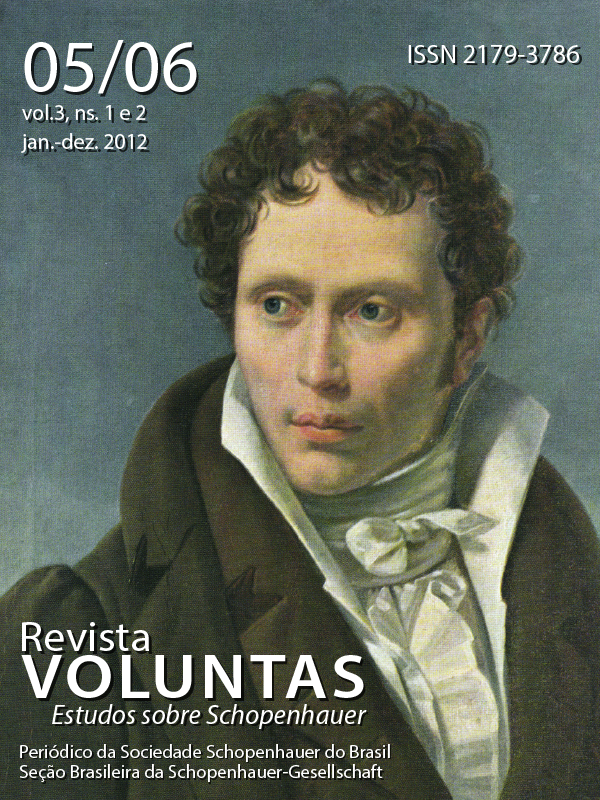A proximidade entre gênio e loucura: um estudo sobre a estética de Schopenhauer
DOI:
https://doi.org/10.5902/2179378634028Schlagworte:
Estética, Loucura, Gênio artísticoAbstract
O tratamento da estética de Schopenhauer forma um dos aspectos centrais de sua extensa visão filosófica de mundo. Apesar do tratamento ser perspicaz e sensível, a análise do gênio criativo conecta-se com o mais periférico exame da loucura no sentido em que ameaça solapar a concepção de Schopenhauer do eu. A loucura é caracterizada pela descontinuidade do self do indivíduo, que convida a uma comparação com a transição para a pura subjetividade da empírica subjetividade cotidiana durante a contemplação estética. Uma comparação com a loucura é até mais relevante para o gênio cuja exposição aos elementos sublimes da natureza está em paralelo com a exposição ao horrível que o louco é exposto. Ao comparar o princípio da loucura com o do estado estético, pode ser colocado em questão o que preserva a nossa identidade em toda a nossa mudança na subjetividade. Como Schopenhauer argumenta nosso conhecimento sobre a vontade é insuficiente, um apelo a isto como a fonte de continuidade é insatisfatórioDownloads
Literaturhinweise
ATWELL, J. E., ''Art as liberation: a central theme of Schopenhauer's philosophy''. In: Dale Jacquette
(ed.) Schopenhauer, Philosophy and the Arts. Cambridge: Cambridge University Press, 1996, pp. 81-106.
GARDNER, S., ''Schopenhauer, Will, and the Unconscious''. In: The Cambridge Companion to Schopenhauer, by Christopher Janaway (ed.). cambridge: Cambridge University Press, 1999, pp. 375-421.
GARDINER, P. Schopenhauer. Harmondsworth: Penguin Books, 1963.
GUYER, P. ''Pleasure and knowledge in Schopenhauer's aesthetics''. In: Dale Jacquette (ed.), Schopenhauer, Philosophy and the Arts. Cambridge: Cambridge University Press, 1996, pp. 109-132.
JACQUETTE, D. The Philosophy of Schopenhauer. Cesham: Acumen Publishing Limited, 2005.
JACQUETTE, D. ''Schopenhauer's metaphysics of appearance and Will in the philosophy of art''. In:
Dale Jacquette (ed.), Schopenhauer, Philosophy and the Arts. Cambridge: Cambridge University Press, 1996, pp. 1-36.
JANAWAY, C. ''The real essence of human beings: Schopenhauer and the unconscious will''. In: Angus Nicholls and Marting Liebscher (eds.), Thinking the Unconscious: Nineteenth-Century German Thought. Cambridge: Cambridge University Press, 2010, pp. 140-155.
KRUKOWSKI, L. ''Schopenhauer and the aesthetics of creativity''. Cambridge University Press, 1996, pp.62-80.
MAGEE, B. The Philosophy of Schopenhauer. New York: Oxford University Press, 1983.
SCHOPENHAUER, A. The World as Will and Representation. 2 vols. E. F. J. Payne, trans. New York:
Dover Publications, 1966.
SCHOPENHAUER, A.On the Fourfold Root of the Principle of Sufficient Reason. E. F. J. Payne, trans. LaSalle: Open Court Publishing Co., 1974.
SCHOPENHAUER, A. On the Freedom of the Will. K. Kolenda, trans. Oxford: Basil Blackwell, 1985.
YOUNG, J. Willing and Unwilling: A Study in the Philosophy of Arthur Schopenhauer. Dordrecht:
Martinus Nijhoff Publishers, 1987.
Downloads
Veröffentlicht
Zitationsvorschlag
Ausgabe
Rubrik
Lizenz
Die Einreichung von Originalen an diese Zeitschrift impliziert seitens der Autoren die Übertragung der Rechte zur gedruckten und digitalen Veröffentlichung. Die Urheberrechte für die publizierten Artikel liegen beim Autor, wobei der Zeitschrift das Recht zur Erstveröffentlicheng zukommt. Die Autoren dürfen dieselben Resultate in anderen Publikationen verwenden, wenn sie deutlich auf unsere Zeitschrift als ursprüngliches Publikationsmedium hinweisen.
Lizenz
Creative Commons Namensnennung - Nicht-kommerziell - Weitergabe unter gleichen Bedingungen 4.0 International (CC BY-NC-SA 4.0).






